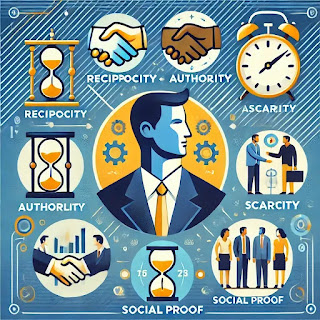45. Social psychology – Influence and
Persuasion: The Power to Shape Minds
Influencing or persuading others goes
beyond mere techniques—it’s a psychological force. Influence is the ability to
change others’ choices and actions, while persuasion is the process of
achieving this.
In this post, we’ll focus on influence, how it differs from persuasion,
and the key factors that build trust and drive people to action.
1. Influence vs. Persuasion: A Broader
Perspective
(1) Persuasion is a Subset of Influence
- Persuasion involves conveying specific messages or evoking
emotions to move others.
- Influence encompasses persuasion and broader methods, including
behavior, attitudes, and social structures.
(2) Different Forms of Influence
- Direct Influence: Making explicit
requests or expressing intentions.
- Example: A team leader instructing
members to adhere to meeting schedules.
- Indirect Influence: Encouraging
actions through social norms or group atmosphere.
- Example: Joining a recycling
initiative because most colleagues are doing it.
2. Key Components of Influence: What
Drives People?
(1) Trust
- Trust forms the foundation of any influence.
- How to Build It: Be transparent
and honest in your actions.
- Example: Using data-backed
arguments or avoiding manipulative tactics.
(2) Consistency
- Repeatedly delivering consistent messages or actions
strengthens influence.
- Example: Activists continuously
sharing their vision to inspire public participation.
(3) Empathy
- Understanding and connecting with others’ emotions increases
trust and influence.
- Example: A salesperson sincerely
listening to a customer’s concerns.
(4) Network Effect
- Influence grows stronger within interconnected networks.
- Example: A message spreading on
social media, shaping public opinion.
(5) Role Modeling
- Actions of influential individuals carry inherent persuasive
power.
- Example: An athlete promoting
environmental causes and inspiring their fans to join.
3. Psychological Drivers Behind People’s
Actions
(1) The Need to Belong
- People have a desire to be part of a group.
- How to Leverage It: Campaigns
framed as “Everyone’s participating” can drive higher engagement.
(2) Fear of Change
- Many resist new behaviors due to discomfort or uncertainty.
- How to Address It: Highlight the
tangible benefits of change to ease resistance.
(3) Rewards and Recognition
- People are motivated by acknowledgment and incentives.
- How to Use It: Encourage actions
with praise and tangible rewards.
(4) Power of Logic and Data
- Logical arguments and data enhance credibility and persuasion.
- Example: Providing reliable
statistics to validate a proposal.
4. Approaches for Sustainable Influence
(1) Emphasize Mutual Benefits
- Influence and persuasion should create value for all parties
involved.
- Example: “This project will help
both the company and employees grow.”
(2) Highlight the Positive Impact of
Actions
- Show how small actions can lead to significant outcomes.
- Example: Demonstrating the
environmental impact of recycling a single bottle.
(3) Offer Choices, Not Demands
- Giving people options increases the likelihood of voluntary
actions.
- Example: “Which of these two
approaches do you think works best?”
(4) Take a Long-Term Approach
- Focus on building lasting relationships and trust rather than
short-term results.
- Example: Nurturing customer
relationships to gradually encourage behavioral changes.
Conclusion: Influence is Built on
Relationships and Trust
Influence is not just about moving people;
it’s about forming relationships and building trust.
Ethical and genuine influence can drive positive change not only for
individuals but also for organizations and society as a whole.
Focus on trust and empathy to inspire actions and shape meaningful connections.

Comments
Post a Comment